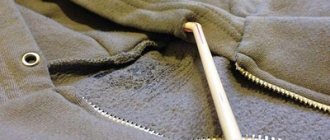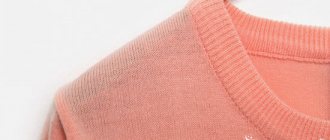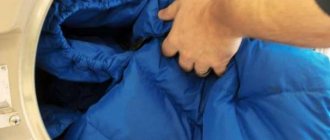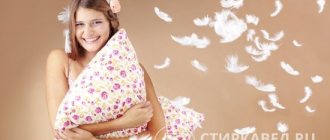In the wardrobe of most women you can find at least 2-3 dresses. They are made from different materials, each of which needs proper care.
Ignorance of the basic “laws” of washing can cause irreparable damage to an item. To prevent this from happening, you need to consider a number of important points.
We will tell you in the article how to wash a dress (linen, velvet, silk, satin, suede, etc.) in a machine and by hand, and how to make sure the item does not fade.
How to prepare for washing?
Before you start washing the dress, you need to find the label on it and read the recommendations for caring for the product. Important information is encoded on the tag in the form of symbols. It concerns the temperature regime, the possibility of washing in a machine, and ironing features.
You need to remember that it is strictly forbidden to subject products made from the following fabrics to automatic processing:
- leather;
- suede leather;
- velvet;
- natural silk.
Some products are completely contraindicated for contact with water . In this case, they are either dry cleaned or handed over to professionals.
Ironing knitwear
This procedure also contains soy secrets. Iron knitwear only from the inside out, almost without touching the surface with the iron. If there is a need to smooth out frills or frills on the front side, be sure to use a damp cloth or material.
But knitwear’s best friend is a steam generator, which will help keep knitwear in its original form for a very long time.
Decorative items made of leather or fur cannot be washed or ironed at home. Clothing with such decorations should be dry cleaned.
How to dry?
to dry the dress after washing according to the following rules:
The room should not be too humid, as this will delay the drying process.- Outdoors, water evaporates faster, but it is important to protect the product from exposure to ultraviolet radiation.
- Items made from delicate fabrics are laid out on a flat surface. Coarser materials can be placed vertically, hanging by hangers.
- Do not dry your dress on a radiator.
Most often, the product is not wrung out after washing; the water is allowed to drain on its own. To speed up this process, you can wrap it in a terry towel. This way the water will be absorbed faster.
Silk product
Chic silk dresses will adorn any woman, which is why they are so loved by the fair half of humanity. You cannot wash silk outfits in an automatic machine; only manual cleaning of the products is allowed. The algorithm of actions will be as follows:
- fill a basin with water at a temperature of no more than 40°C;
- add a gentle detergent;
- soak the dress in the container for 10-15 minutes;
- wash the item, avoiding strong mechanical impact (do not rub, squeeze, twist the fabric);
- rinse the outfit several times, gradually reducing the water temperature. The final rinse should take place in cold water. Air conditioning may be used. The rinse aid will protect silk from electrification, protect it from shedding, and smooth out the fibers of the material.
Silk items cannot be twisted. You need to take the item out of the water and lay it out on a terry towel or sheet. It’s better to put another piece of cloth on top and, pressing with your palm, remove excess moisture from the silk. The dress is also dried in a horizontal position.
When should you go to dry cleaning?
You should contact a dry cleaner if you cannot get rid of dirt at home . Most often, professionals are trusted with valuable items, such as wedding dresses, items made of suede and genuine leather.
Dry cleaners that value their reputation never require advance payment. They warn the client in advance about possible consequences, since some stains cannot be dealt with even with the use of professional household chemicals.
Such organizations have existed on the market for a long time, so they have many positive reviews. The cost of the dress washing service depends on the complexity of the task. Prices start from 600 rubles and above.
Combating the main problem of knitwear – pilling
These unpleasant, unaesthetic and unsightly lumps of lint form on the surface of the material as a result of improper care. Another reason for this rolling may be friction. Often, pellets form on the elbows, in places where a bag or other accessories rub against clothing. It is difficult to combat this phenomenon, but it is possible.
In the “civilized world” they came up with special machines to combat pellets. But our women are not looking for easy ways, so to combat this problem, a variety of means are used - tape, toothpicks and even razors.
Knitted clothing can give a lot of pleasant moments in comfort and aesthetics, but in return it requires careful care and attention. The simple recommendations outlined above will give your clothes longevity.
What to do if the item shrinks?
If the dress has shrunk, you can stretch it in the following way:
- Soak the product for 20 minutes in a weak vinegar solution (for 10 liters of water you will need 3 tablespoons of 9% vinegar).
- After 15 minutes, remove it, squeeze it lightly and place it on a horizontal surface.
- While drying, stretch the dress in the desired direction.
This method allows you to increase the product by 1 size. Woolen items can be stretched best. Dresses made of cotton and linen react worse to the procedure.
A lot of useful information on how to stretch a dress that has shrunk after washing and how to prevent the product from shrinking in the future is presented in this article.
Selecting a detergent
It is not recommended to use regular washing powder for washing knitwear - it does not rinse well, and delicate fabric may become damaged after contact with it. Several means are acceptable:
- Soap solution. Laundry soap is rubbed on a fine grater and the shavings are dissolved in water.
- Gel for washing delicate fabrics.
- Shampoo. If you don’t have a special product at hand, you can use any hair shampoo.
- Hard water can deteriorate the appearance of a knitted product; to soften it, use baking soda - about 1 teaspoon will be needed for a medium-sized basin.
- Do not use bleach for knitwear. If it is necessary to make the item white, after washing it, rinse it in water with the addition of a small amount of hydrogen peroxide. A couple of tablespoons of salt or vinegar will help return faded fabric to its rich color - they are dissolved in a bowl of water when rinsing.
Important Tips
To wash your dress successfully, you must follow the following recommendations:
- Before cleaning, turn the product inside out;
- do not use products containing bleaching components for black and colored items;
- preference should be given to liquid detergents;
- Do not wash white and colored items together.
The first time you wash the product carefully, observing all safety precautions.
You will find maximum useful information about washing clothes and various fabric products here.
General recommendations:
- Large stains should be removed separately, then machine washed.
- It is recommended to lubricate metal jewelry with glycerin. It will protect the product from oxidation and rust.
- There is no need to put off washing your holiday dress for long. Fresh stains and dirt are easier to remove when they are still fresh and have not become embedded in the fibers. It is advised to start putting things in order on the second or third day after the wedding.
- The optimal temperature of the liquid is 30-35 degrees.
- If possible, you should remove the decor or its individual elements from the wedding item: pearls, three-dimensional rhinestones, flowers and brooches.
- It is necessary to wash a wedding dress in a washing machine without the spin function.
- The cleaning agent is selected according to the type of material and its composition.
Washing a wedding dress: what to pay attention to?
Mostly salons offer dry cleaning services for dresses.
Usually, after each client, dry cleaning is carried out to remove sweat stains, dust from the hem, and dirt. Indeed, in most cases, even in dry weather and on a sunny summer day, especially if the dress is long and drags along the floor, dusty traces remain that need to be removed. Washing a wedding dress - what to pay attention to:
- However, if the contamination is quite serious, red wine has been spilled on the dress, or the hem is stained with grass or grease stains, the wedding salon may require an appropriate fee.
- We recommend paying for it and not cleaning the dress yourself. The fact is that it is not completely known what fabric was used to sew the dress. Very often they use rather fragile, delicate fabrics and materials that will not survive washing.
- They must be cleaned exclusively by dry cleaning. However, there are still a number of fabrics that can be washed.
Dirty hem
Proper stain removal
Sweat
- In order to remove fresh dirt, you can use baby laundry detergent. You will need 60 g of the drug per 500 ml of hot water (40 degrees). After the product has completely dissolved, the liquid is applied to sweat stains. After 5-7 minutes, the powder is washed off with warm water. The procedure should be repeated 2-3 times.
- Yellow stains are removed with saline solution. One tablespoon of salt dissolves in 100 ml of water. The resulting composition is applied to the stained area, then washed off.
Wine and champagne
- Ammonia will help get rid of wine stains. One part of the product is diluted with one part of water. This liquid is applied to the dirt with a clean sponge. When the stain becomes lighter, it is sprinkled with baby talcum powder, which will absorb the dirt. The dried composition is shaken, the wedding product is rinsed in warm water.
- You can remove fresh red wine stains with soda. The affected part of the clothing is soaked in soda for three hours.
- A soap solution can also remove traces of alcohol. The contaminated area is stretched. From above, a hot solution is poured onto the stain in a thin stream until the stain completely disappears.
Grass
- Small grass stains can be easily removed with a saline solution. Two tablespoons of table salt are diluted in 250 ml of water. The problem area is soaked in the product for 15-20 minutes. The item is rinsed in soapy water.
- Green stains are wiped off first with a soapy sponge soaked in washing gel, then with a rag soaked in an ammonia solution. At the end, the composition is washed off with water.
Food
- Mineral water can rid your dress of marks and stains after eating. The item is soaked in mineral water for 3-4 hours, then rinsed in warm water.
- Grease stains can be removed using dishwashing detergent. The affected area is rubbed with the preparation, then rinsed.
Pomade
- Talc or starch will help get rid of lipstick stains. The powder is rubbed into the greasy stain, when it absorbs the dirt and dries, the outfit is shaken. After this, the item is washed in soapy liquid or treated with a solution of ammonia.
Washing jeans
Regular denim items can be reduced by a size by washing them in very hot water. The fabric will fade a little and the water will turn blue or black, but this is not critical. But you won’t be able to shrink a stretch denim item. They even have a “shrink to fit” label on them.
When washing in a washing machine, set the temperature to between 60 and 90°C. The maximum spin is required. Drying can be done by machine, or simply hang things on a very hot radiator.
When washing by hand, alternate between very hot water and ice water. Then the thing will definitely decrease in size.
Unfortunately, jeans can become not only narrower, but also shorter. This nuance must be taken into account.
Ironing
After drying, ironing follows. Maximum attention is paid to this process, since one careless movement will lead to damage to the product.
Ironing begins after the wedding dress has completely dried. Temperature and other details depend on the type of fabric.
How to iron correctly:
- The satin is ironed on the reverse side so that the front side looks like new. Temperature - 140–150°C.
- Taffeta is ironed with a damp cloth from the wrong side. Temperature - up to 50°C.
- The crepe is ironed at a temperature of 110–120°C. No special approach is required, but you shouldn’t hold the sole in one place for a long time. It is advisable to iron through fabric.
- Silk is ironed dry. Use a thin, damp cloth; do not splash water on the material itself, as stains will appear. Temperature: 60–80°C.
- Organza needs protection. To avoid deformation of the fabric, ironing should be done through the fabric. The heating temperature should be no more than 40°C.
- It is recommended to steam chiffon and tulle only. Use an iron with this function or a steamer. Temperature: 60–80°C.
- Lace requires a special ritual. First it is starched, then ironed. The temperature should not exceed 100°C.
- Velvet is ironed from the wrong side, barely touching the material with the sole of the iron. Heating temperature: maximum 100°C.
- Cotton Temperature - 140–170°C.
After ironing is completed, the dress is left to cool on hangers. When all the events are over, the outfit is put in a case and hung in the closet.
How to iron a wedding dress











